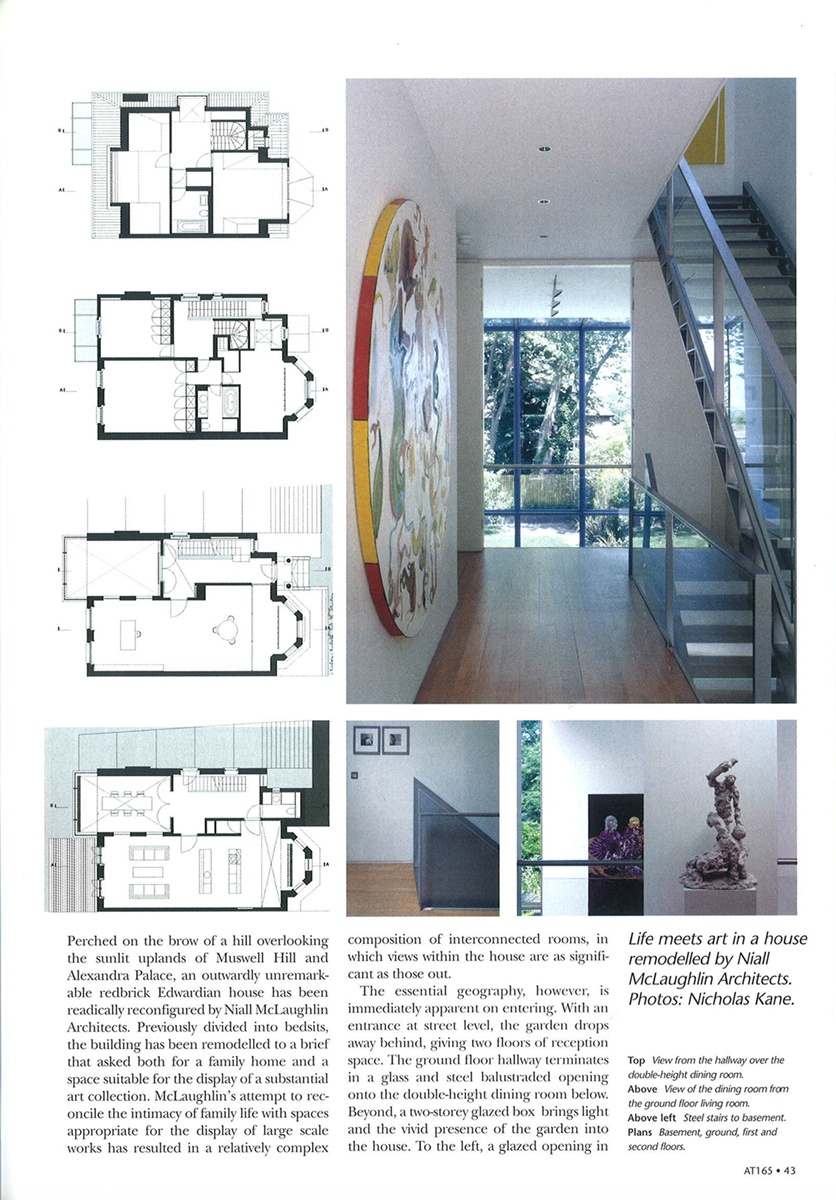House at Crouch End - Architecture Today
Issue 165
February 2006
Text Chris Foges
Images Nick Kane
Life Meets Art in a house remodelled by Níall McLaughlin Architects.
Perched on the brow of a hill overlooking the sunlit uplands of Muswell Hill and Alexandra Palace, an outwardly unremarkable redbrick Edwardian house has been radically reconfigured by Níall McLaughlin Architects. Previously divided in to bedsits, the building has been remodelled to a brief that asked both for a family home and a space suitable for the display of a substantial art collection. McLaughlin’s attempt to reconcile the intimacy of family life with spaces appropriate for the display of large scale works has resulted in a relatively complex composition of interconnected rooms, in which views within the house are as significant as those out.
The essential geography, however, is immediately apparent on entering. With an entrance at street level, the garden drops away behind, giving two floors of reception space. The ground floor hallway terminates in a glass and steel balustraded opening onto the double-height dining room below. Beyond, a two storey glazed box brings light and the vivid presence of the garden into the house. To the left, a glazed opening in the wall overlooks another double-height space, a slot running between the ground floor living room and the kitchen below. Both rooms also open onto the dining room, via doors from the kitchen and another glass balustraded opening above.
The logistics of display are the principal determinant of the internal organisation. Most significant, perhaps, is the impact on orientation. While daylight from the north-facing garden has been maximised, south light is filtered by a combination of frosted glass over the original stained glass windows and a scaly screen of perforated bronze leaves that hangs in the double-height slot behind bay windows to the ground floor and basement. Consideration extends to the arrangement of individual rooms – wall space is maximised, for example, so the kitchen consists of two islands – and to telling details: walls are kept clear of light switches and sockets, which are instead recessed into the floor.
There is no sense, however, that the house is treated as a pristine gallery space around which domestic life must somehow fit. The close interrelation of spaces across three storeys – an internal window to the first floor study makes a further visual connection to the hallway – means that one is constantly aware of the presence of both. The house does become progressively more domestic the further it is ascended. From the ground floor a steel staircase leads to the main bedroom, bathroom and study. This gives way to a wooden stair to the second floor, which contains a further two bedrooms and a bathroom. Steel-framed glazing on the lower two floors is succeeded by rebuilt copies of the original wooden windows above ground. This balance is echoed in the successful mixture of the dramatic gesture with details that are artful but ‘honest’. Niches accommodate tall wall-mounted radiators, but do not disguise their presence. The glazing bars of the rear extension are formed from standard steel angles and a positive virtue is made of the mdf sheets that line the staircase on the upper floor, whose edges are chamfered to make v-shaped grooves at the joins.
